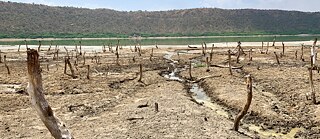Somewhere in the Middle of Nowhere
“Time has stood still here for millennia”
Lonar Lake is India’s cosmic wonder and the subcontinent’s best-kept secret. Nothing has changed here for over 50,000 years.
Tourists from all over the world visit the famous cave temples of Ajanta and Ellora — World Heritage Sites of India — but the lesser-known Lonar Lake is not often among their destinations. It is located off the tourist trail in the Buldhana district of the state of Maharashtra. It is a three-hour drive from Aurangabad. According to scientists, the lake is located in the world’s only crater formed by a high-speed impact on basaltic rock — namely, when a meteor hit the earth at about 90,000 kilometers per hour. Today, the area of the lake covers 77.69 hectares within the 3.66 square kilometers of the Lonar Protected Area.
Surreal Sight
Most visitors stay overnight in Aurangabad and make their way to Lonar by road from there, although the lake is very close to a Maharashtra Tourism Development Corporation (MTDC) resort and only a short hike through the jungle away. After just a 30-minute walk through the jungle, the lake is reached. Along the way, the green canopy of tree tops protects you from the burning rays of the summer sun on the Deccan Plateau.
Near the lake, the first dead tree trunks appear before you emerge from under the canopy and glimpse the stunning landscape of Lonar Lake. From the ancient Gomukh Temple on the hill, the oval lake, which fits into the landscape like a saucer, can be seen particularly well. The green water glistens in the sunshine. The sight is surreal.
Quiet Home for Blue and Green Algae
“This place has been standing still for over 50,000 years. Many tourists come here and are stunned to see the sight. The dead tree trunks on the bank of the lake are a reminder of stillness. Time has stood still here for millennia,” explains Suren Dhaman, a guide accredited with the MTDC, “The crater has become a natural lake. The water is saline and alkaline with blue and green algae growing in it.” Armed with a lemon, litmus paper, and a small plastic cup, Dhaman checks the salt and sodium content of the lake water.
Dhaman explains that the lake’s surface is calm and that while there is no aquatic life in the lake itself, the lake’s green surroundings provide a habitat for birds and reptiles. “There are around 160 birds, 40 species of reptiles, and many mammal species. Migratory birds like the black-winged stilts, Brahminy ducks, shelducks, teals, herons, baya weavers, parakeets, tailorbirds, magpies, and robins can be spotted early in the morning. We also have monitor lizards in the lake periphery, and there are hundreds of peacocks, chinkara, and gazelles too,” Dhaman says. Despite the diversity of species, no signs of vegetation can be found in the mud belt around the lake because of the high soil alkalinity. With the exception of dead tree trunks and birds picking algae from the lake, there is no sign of life. The silence is broken only by the chirping of birds and the occasional visitor.
Geologically Unique
At the other end of the lake on its lush shore near the Shankar Ganesha Temple, it is clear that here science fiction meets nature and religion, and chemistry meets Indian mythology. Those who have never had the feeling of being at the end of the world will certainly feel it in this place. The silence is suddenly disturbed by a group of monkeys equipped with plastic bottles, squatting in the trees near another temple ruin — reminding us of the civilization we had actually left behind at the beginning of our hike.
According to NASA, Lonar Lake was formed 35,000 to 50,000 years ago by the impact of a meteorite. In 1823, British officer C.J. Alexander designated the site a unique geographic landmark. It was finally declared a national geological monument in 1979. Dhaman reports that the lake is mentioned in ancient scriptures, including the Skanda Purana, the Padma Purana, and the Aaina-e-Akbari, or the “Administration of Akbar,” which is a 16th-century document chronicling the administration of the Mughal Empire under Emperor Akbar.
In November 2020, Lonar Lake was declared Maharashtra’s second Ramsar site. Ramsar sites are wetlands of international importance. The convention of the same name was concluded in Ramsar, Iran, in 1971 and aims to halt the loss of wetlands worldwide.
Opening up for Tourism
The lake is not yet a tourist hotspot, but the Maharashtra government is already developing plans to protect it and develop it as a tourist destination. “The Lonar Crater has its own significance in tourism and geology. As it becomes a Ramsar site, it will help us protect it better in the years to come. I’m glad that the Lonar Crater is now officially a Ramsar site. Having seen it for the first time in 2004, it is a sight that captivates everyone. It has its own significance in the world of biodiversity, tourism, and geology,” Maharashtra Environment and Tourism Minister Aaditya Thackeray said when Lonar was declared a Ramsar site.
However, the statement also cautioned that the lake was being threatened by sewage and unsustainable tourism. In February 2021, Maharashtra’s Chief Minister Uddhav Thackeray paid a visit to Lonar and urged relevant authorities to develop tourism facilities on-site without disturbing local biodiversity:
“Lonar Lake is very popular with scientists who visit here in large numbers. Arrangements should be made to attract all kinds of tourists. The lake has huge biodiversity around it and development of the place needs to be done in a proper manner,” Thackeray had said.
Lined With Temples
On our way back, we stopped at the Gomukh Temple located on the crater rim. Gomukh means “cow’s mouth,” and a never-ending stream of clear water pours from the mouth of a cow’s head. Pilgrims visiting the temple wash in this jet of water or in a temple pond or stepwell next to it. The most interesting temple is located in the center of Lonar and is well worth a visit. According to mythology, the Daitya Sudan Temple is dedicated to the god Vishnu who killed the demon Lonasura after whom the town and lake are also named. According to Dhaman, a local legend says that Lonasura hid in the crater, and the lake’s water was darkened by his blood.
The Daitya Sudan Temple is reminiscent of the famous Khajuraho Temple with its animal figures and erotic sculptures of lovers. The temple has three chambers. Entering the sanctum sanctorum inside the temple, one sees an image of the god Vishnu bent over Lonasura. As in many mythological tales, good triumphs over evil.
Stepping out of the temple feels like stepping back into reality. And although visitation to Lonar has been down since the COVID-19 pandemic, Dhaman is optimistic. “The lake has stood here for over 50,000 years. Compared to that, two years is just a drop in the lake. We hope that more people come here to experience this cosmic wonder. Just a small tweak in the cosmos, and we have etched an indelible imprint on earth forever. Some places bring calmness with excitement, mystery, and intrigue. Lonar Lake is one such place,” says Dhaman.






